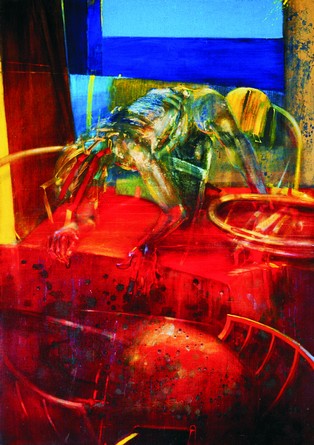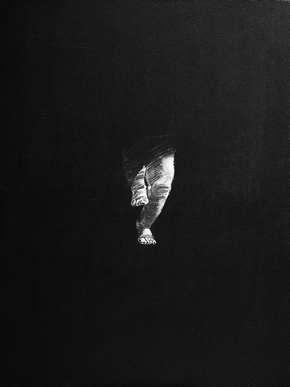STATES OF THREAT, GARDENS OF MEMORY
From an article on Józef Walczak by Anna
Król

The paintings of Józef Walczak lead us astray.
They epitomise the unsaid, the unbearable. They convey the terrifying side
of reality and the appalling nature of our existence. In fact the artist
puts his painting together from a surprisingly few objects-cum-props. This
may be the interior and in it an armchair, table, wineglasses, cushions
and drapes, a dark opening in a door or one lit up in the window, a handrail
suffused with light and an arch making its reappearance.

Perhaps there is someone disfigured, maimed, fettered
taking on changing roles imposed by the artist such as an unnamed nude,
mythical titan Prometheus or Don Quixote. These same objects or rather
their fragments and signs, appear in subsequent compositions. At times
everything is clear and simple. At times it is with great difficulty that
we manage to identify the shapes and attempt to unravel the artistic convention
that is conveyed to us. Walczak provides one insight: ‘I work on the painting
in two directions at a time, shaping the form of the subject and comment
on the subject matter sometimes to the very end and at the same time, define
its environs. [...] I throw waste material there, which has no reference
to reality. If I manage to finalise the form of the subject to the end,
I then consider the main thing or figure was sufficiently made concrete,
then it will make its way through the entire canvas. I then begin to break
it apart. The result of my perfect work becomes broken apart by means of
the brushwork. The environs of the subject matter, which I had up to now
treated with a certain casual manner, I now begin to clear of all that
is superflous. [This is the second of my directions]. The moment that I
consider a balance occurrs in how I treat matter and its environs, I cease
work on the painting.’1 This state of equilibrium, it may be said, is a
painful trial for the viewer.These dynamic and colourful compositions created
with bravado, burst the banks of defined constraints, seeking their outlet.
They speak again about the fact that harmony of light is but seeming, with
objects changing shape and nature. Reality appears as a threatening and
mysterious domain, hiding initial fears and the demons in waiting. The
artist — like a witch doctor — casts a spell on all these, embodying himself
in amongst the reverberating tissues of paint. That is why in addition,
the unknown element of threat and anxiety dominating in paintings, does
not blanket ‘theirgusto’ and paint handling mastery. The painterly being
of Walczak, however, does not entice or charm for it seems to be totally
subordinated to the externalisation of our daily misterium tremendum.

Walczak paints nudes, still lifes,
interiors — the basic iconography of a painter; eternal, elementary and
altruistic. Moreover, he creates compositions that relate to the great
themes and cultural myths of the Mediterranean world. The painter thereby
introducing universally known motifs, ones deeply rooted in literature
and the fine arts, evokes a series of associations in the viewer that have
to be confronted. Thanatos, Prometheus, Midas — are all figures chosen
deliberately, as is Don Quixote. Moreover, the Pozna? artist conveys a
painting within a painting, as in the portrayal of Marat. His imagination
and memory appear to inhabit numerous figures that demand to be revealed
and made large on canvas. Walczak does not step back from naming his paintings,
knowing that ‘the title can take over all explanatory elements, adding
commentary, suggestion, [for it is] tied to the picture yet [it finds itself]
beyond it, not at all like [a break of] its structure in any way.’ The
title is only a road sign for interpretation, giving direction, not guaranteeing
that the aim is within reach.
Translated from the Polish by Ryszard Reisner
|

![]() © 2003-2005 Ars Interpres Publications.
© 2003-2005 Ars Interpres Publications.